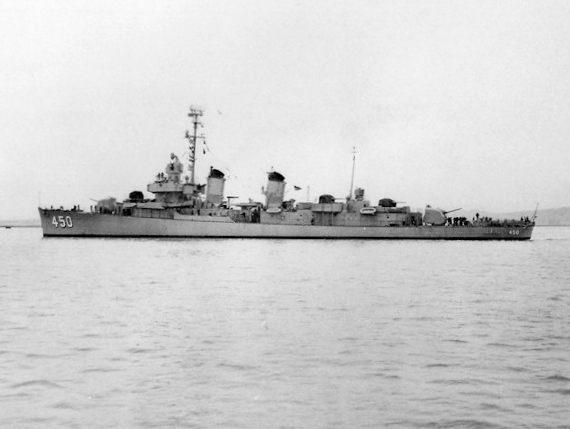How Potatoes Changed the Outcome of a World War II Naval Battle

The warship pictured above was the USS O’Bannon, which served in the United States Navy during World War II and the Korean War. The destroyer’s armament was impressive by any measure — depth charges for submarines, seventeen anti-aircraft guns, torpedo tubes for ships and subs alike, and five 5″/38 caliber guns for surface targets. There were few threats that the O’Bannon and other ships in its class didn’t have an answer for.
But in April of 1943, while in the Pacific, the O’Bannon’s crew was faced with one of those exceptions. It detected the Ro-34, a Japanese submarine, which for some reason had surfaced. The O’Bannon’s officers decided to ram the Ro-34, which would have almost certainly sunk the sub while doing little damage to the destroyer, but before the O’Bannon made contact, its leadership realized that the plan had a flaw. The Ro-34, the officers feared, may have been laying mines in the water — a reasonable conclusion given that it had come to the surface — and therefore, getting the O’Bannon too close could be a fatal error. The O’Bannon turned hard, avoiding the intended collision, and ended up cruising right next to the submarine (which, it turned out, wasn’t laying mines). The Japanese went to their surface gun, intending to fire on the O’Bannon.
As it turned out, the Japanese had the Americans exactly where they wanted them. The O’Bannon, despite its weaponry, had no way of defending itself, as none of its weapons were designed for close combat. Those 5″/38 caliber guns, for example, could hit targets ten or twenty football fields away, sure, but ten or twenty meters? Not a chance. To make matters worse, the crewmen aboard the O’Bannon weren’t expected to be in close combat, so they weren’t carrying guns. Even though they could have pretty easily shot the Japanese submariners, they simply weren’t armed to do so. At a loss for what to do next, the sailors looked for a readily available projectile to hurl at their enemies. And there was a plentiful one nearby: potatoes.
In most cases, that wouldn’t be a very good plan — while airborne tubers could hurt, they’re no match for a submarine-mounted gun. But the untold number of flying potatoes were, perhaps unexpectedly, effective. The Japanese crew didn’t think they were being bombarded with starchy vegetables; rather, they thought the Americans were throwing hand grenades. Fearing the onslaught of hand-thrown explosives, the Japanese took cover, leaving the gun on the deck unmanned as the ship retreated from the O’Bannon and began its descent beneath the surface.
This, to say the least, was a mistake. Had the Japanese simply ignored the flying potatoes (or stored them for later eating), the submarine would have likely inflicted heavy damage to the destroyer. Of course, that’s not what happened. By fleeing, the Japanese not only gave up the upper hand but also put themselves in harm’s way. The O’Bannon now had enough distance between itself and the Ro-34 to fire its weapons and launch its depth charges — which it did with great success. With help from another U.S. destroyer, the O’Bannon sank the Ro-34. All 66 crewmen and officers aboard the Japanese ship were lost, and the 300 or so Americans survived to see another day.
Bonus Fact: In the late 1700s, there was a very successful British racehorse named Potoooooooo, pronounced “potatoes.” The reason for the strange spelling? As Wikipedia notes, the horse’s original name was “Pot-8-Os” but a stable boy got confused and wrote out all eight “o”s on the horse’s feed bin. The horse’s owner, amused by the alternative spelling, kept it.
From the Archives: Attack of the Killer Potatoes: Unlike the ones thrown by the O’Bannon’s crew, these taters can kill.
Take the Quiz: Name the world’s largest potato producers. Also, name the three hobbit-approved ways to prepare potatoes.
Related: “Potato: A History of the Propitious Esculent” by John Reader. 4.6 stars on 11 reviews. And yes, I had to look up the last two words in the title.
